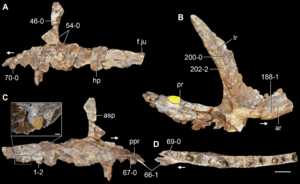Kalisuchus facts for kids
Quick facts for kids Kalisuchus |
|
|---|---|
 |
|
| Holotype maxilla (QM F8998) and referred pterygoid (QM F9521) of Kalisuchus rewanensis | |
| Scientific classification |
|
| Kingdom: | Animalia |
| Phylum: | Chordata |
| Class: | Reptilia |
| Clade: | Crocopoda |
| Clade: | Archosauriformes |
| Genus: | †Kalisuchus Thulborn, 1979 |
| Type species | |
| †K. rewanensis Thulborn, 1979
|
|
Kalisuchus (say: Kah-lee-SOO-kus) was an ancient reptile that lived about 250 million years ago. Its name means 'Kali's crocodile,' named after Kali, a Hindu goddess of destruction. This name was chosen because only small, broken pieces of its bones were found. Kalisuchus was discovered in Australia, in a place called the Arcadia Formation in Queensland.
This creature lived during the Early Triassic period, specifically in the Induan age. This makes Kalisuchus one of the oldest known archosauromorphs (a group that includes crocodiles, dinosaurs, and birds) found in Australia. The only known species is K. rewanensis, named after the Rewan Group where its fossils were found.
Contents
What did Kalisuchus look like?
The most important fossil of Kalisuchus is a part of its left upper jaw bone, called a maxilla. This main fossil is known as the holotype. Scientists also found other bone pieces in the same area. However, it's hard to be completely sure if these other bones belonged to Kalisuchus because they don't connect directly to the main jawbone.
One of these other bones was first thought to be a cheekbone. But later, scientists realized it was a bone from the roof of its mouth, called a pterygoid. This bone looked similar to those found in other large, ancient reptiles called erythrosuchids.
Its Jaw and Teeth
The upper jaw of Kalisuchus had a short front part. The back part of the jaw, which formed the front edge of a large opening in the skull (called the antorbital fenestra), was tall and stood almost straight up. Unlike some other early archosauriforms, this opening had a gently curved edge, not a deeply curved one.
Kalisuchus had teeth that were unusual. They were set deep into sockets in the jawbone and were fused to the bone. These teeth were also flat from side to side, curved backwards, and had serrated (saw-like) edges on the back. This type of tooth is common in meat-eating archosauriforms.
Size and Lifestyle
Scientists believe that Kalisuchus was about 3 meters (almost 10 feet) long. Its jaw structure suggests it might have been a bit like a mix between two other groups of ancient reptiles: the proterosuchids and the erythrosuchids. Proterosuchids were often semi-aquatic, meaning they lived partly in water, similar to modern crocodiles. Erythrosuchids were large, strong land animals.
The way its jaw was shaped, especially a part that curved downwards, suggests that Kalisuchus might have had a snout that also curved downwards. This could mean it lived and hunted in a similar way to the proterosuchids, possibly spending time near water.
How was Kalisuchus classified?
When Kalisuchus was first described in 1979 by a scientist named Thulborn, it was thought to be closely related to Proterosuchus, another early archosauriform. It was placed in the group called Proterosuchidae.
However, in 2016, another scientist named Ezcurra studied these groups more closely. He found that Proterosuchidae was not a single, clear group. Instead, it was a "paraphyletic" group, meaning it didn't include all the descendants of a common ancestor.
Ezcurra noticed that Kalisuchus had special bony plates between its teeth, which suggested it was more advanced than the proterosuchids. But because its jaw had many tooth sockets (14 of them), it was still considered more primitive than other advanced archosauriforms like the erythrosuchids. So, Kalisuchus sits in an interesting spot, showing features that are a mix of older and newer archosauriform traits.
Long, J.A., Dinosaurs of Australia and New Zealand, UNSW Press 1998

